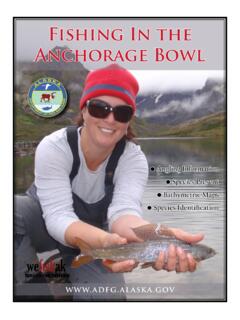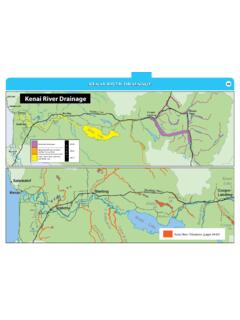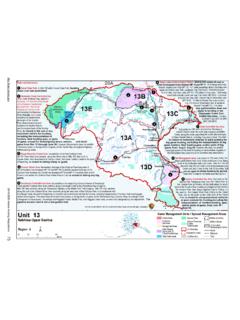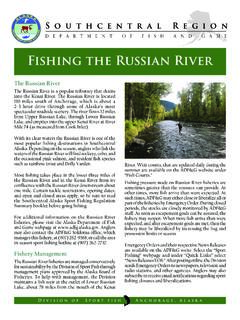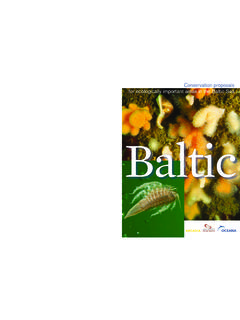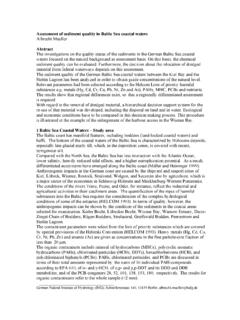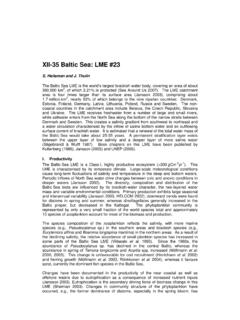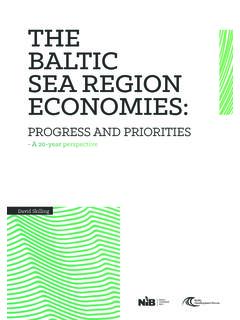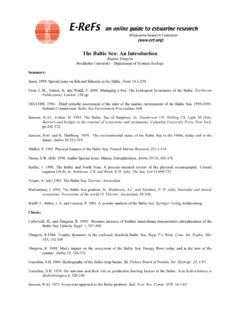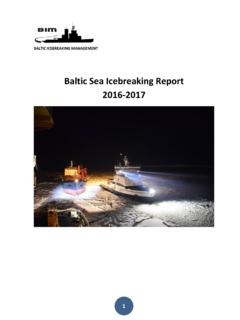Transcription of BALTIC MACOMA - Alaska Department of Fish and Game
1 BALTIC MACOMA MACOMA balthica Linnaeus, 1758 (Tellinidae) Global rank GNR suggested change to G5 (21 Sep2005) State rank S5 (21 Sep2005) State rank reasons Widespread and locally abundant; a dominant member of the intertidal invertebrate community. Trends unknown. Habitat receives protection in some key areas. A staple prey species to migrating shorebirds; bioaccumulation of toxins could amplify risks to its predators. Taxonomy Formerly, M. inconspicua (Harbo 1997, O Clair and O Clair 1998). Based on recent genetic work, Vainola (2003) suggested treating temperate individuals on the Atlantic coast of North America (Virginia north to the Bay of Fundy, also recently introduced to the Pacific coast in California) as a separate species, M.
2 Petalum; within the more northerly M. balthica complex, the related Pacific- BALTIC -White Sea population should be distinguished as subspecies M. b. balthica and the northeast Atlantic population as M. b. rubra. Additional genetic work by Luttikhuizen et al. (2003) found the Alaskan population was closely related to the BALTIC population which corroborates the divisions suggested by Vainola (2003). General description A small marine clam (shell length to >3 cm, most <2 cm); delicate shell is oval shaped and white externally with fine concentric growth lines and a smooth margin; usually deep pink internally, sometimes blue, yellow or orange. The thin, yellowish periostracum on the shell s exterior flakes off easily.
3 Long translucent white siphons can measure up to 10 times the length of the shell and may resemble small white worms. Like other macomas, M. balthica has scars on the insides of the valves, the two siphons are separate to the base, and the incurrent siphon lacks tentacles near the tip. Unique among macomas because the pallial sinuses are large and equal in size with no gap between the pallial sinus and the pallial line (Bernard 1979, Foster 1991, O Clair and O Clair 1998, Field and Field 1999). Length (cm) 2 Reproduction Sexually mature at 8 to 10 mm; spawns late March and April (O Clair and O Clair 1998). Eggs and larvae are pelagic for a short period (2-5 weeks; Luttikhuizen et al. 2003). In England, most settlement of young clams occurs in April and May (O Clair and O Clair 1998).
4 May live as long as 8 years with reduced growth and increased longevity at higher latitudes ( , Copper River Delta, Alaska ; see Powers et al. 2002). Ecology An important food source for coastal birds, especially during winter and migration stopover. Predators include ducks, shorebirds, and gulls. The preferred and principle prey during winter for Red Knot (Calidris canutus) and comprises the entire diet of the Pribilof Rock Sandpiper (Calidris ptilocnemis ptilocnemis) while wintering in Cook Inlet, Alaska (Reading and McGrorty 1978, Dames and Moore 1979, Zwarts and Blomert 1992, Rosier 1993, O Clair and O Clair 1998, Field and Field 1999, De Goeij 2001, Lees et al. 2001, Edelaar et al. 2002, Gill et al.)
5 2002, Richman and Lovvorn 2003, Warnock et al. 2004). Siphons can be nipped off by bottom fish , crabs and shrimp, and constitute an important food for commercially important King (Paralithodes camtschaticus) and tanner crab (Chionoecetes bairdi) in Alaska (Weihs and Burrell 1978). The isopod Saduria entomon preys on both adult and newly settled juvenile clams (Lees et al. 2001). Migration Dispersal takes place during the 2-5 week larval phase. During the first winter, may drift with the use of a mucoid thread (Luttikhuizen et al. 2003). In the Wadden Sea, post-larvae migrate to nurseries on high, silty tidal flats. After the first growth season, juveniles return to low intertidal and subtidal flats (generally between December and March; Hiddink and Wolfe 2002).
6 The observed migration to and from nurseries in the Wadden Sea is presumably an adaptation to avoid predation by shrimp on juveniles and parasitic infection of adults (Hiddink 2003). Food Feeds on detritus from sediment surface using incurrent siphon. Sediments up to 6 cm from the burrow may be taken and ingested. Also a suspension feeder when currents are strong or where it occurs in clean sand substrate. Marine clams are able to turn over large quantities of sediment in a short time period; this process increases the flow of solutes from the sediment into the water and stimulates growth of diatoms and other microalgae and bacteria, thereby enhancing their own food resources (O Clair and O Clair 1998).
7 Habitat Intertidal zone to 40 m, usually buried shallowly (to 20 cm, but usually within 5 cm of surface) in mud or silt, generally in bays and estuaries with lowered salinity (Dames and Moore 1979, Harbo 1997, O Clair and O Clair 1998, Coan et al. 2000). Burrowing depth varies throughout the year, generally shallow in spring/early summer and deeper in late fall/early winter (Edelaar et al. 2002). In Alaska , associated with fine, soft-bottom sediments of quiet bays, estuaries, and occasionally inland rivers (Bernard 1979, Field and Field 1999, ADFG 2000). In Upper Cook Inlet, thrives in muddy areas near river sources and in the lee of promontories (Lees et al. 2001). At the Copper River Delta, highest densities were recorded where tidal inundation occurred for the longest time (Powers et al.)
8 2002). Global range Circumboreal. From the Beaufort Sea, Alaska , south to San Francisco Bay, California. Also occurs throughout the Bering and Okhotsk Seas to Japan. Off northern Europe, occurs in the North Sea (England, Norway and Denmark), BALTIC Sea, Barents Sea, White Sea, in the waters of the Faroe Islands north to Iceland (but no records from Greenland), and as far south as Spain. On the western Atlantic coast, present from Labrador to Georgia (Bernard 1979, Coan et al. 2000, Vainola 2003). State range Occurs in coastal areas from the Beaufort Sea southward, including the Bering Sea, Alaska Peninsula, Kodiak Archipelago, Cook Inlet, Prince William Sound, Gulf of Alaska and throughout Southeast Alaska (Myren and Pella 1977, Dames and Moore 1979, Shaw and Wiggs 1980, Foster 1981, Baxter 1983, Naidu et al.
9 1992, Rosier 1993, Lees et al. 2001, Powers et al. 2002). Global abundance Unknown, but apparently locally abundant in areas not affected by pollution. State abundance Locally abundant. The dominant infaunal organism of a number of tidal flats, including the Copper River Delta, Kachemak Bay, Dayville and Island Flats at the head of Port Valdez, and Upper Cook Inlet, where densities of over 4,000 individuals/m have been recorded (Dames and Moore 1979, Naidu et al. 1991, Lees et al. 2001, Powers et al. 2002). Elsewhere, densities (individuals/m ) at Chinitna Bay were between 2,600 and 4,600 (Dames and Moore 1979), 1,000 at the West Foreland, 450 at Chickaloon Bay, at Kalifornsky Beach in Upper Cook Inlet (Lees et al.
10 2001), and 182 at Three Saints Bay, Kodiak Island (Nybakken 1969). Global trend Unknown. State trend At Dayville Flats, Port Valdez, numbers of large M. balthica clams increased substantially between 1989-92; prior to that, low abundance of large clams was noted in 1971-72; small clam abundance also increased in 1989-1992 relative to 1971-1972, but to a lesser extent. The low numbers of large clams recorded during 1971-72 may have been due to population decline following the 1964 earthquake, which completely removed all fauna from the Dayville Flats (Naidu et al. 1992). The larger numbers recorded between 1989 and 1992 may more closely represent a recovered stock at or near equilibrium (Naidu et al.
